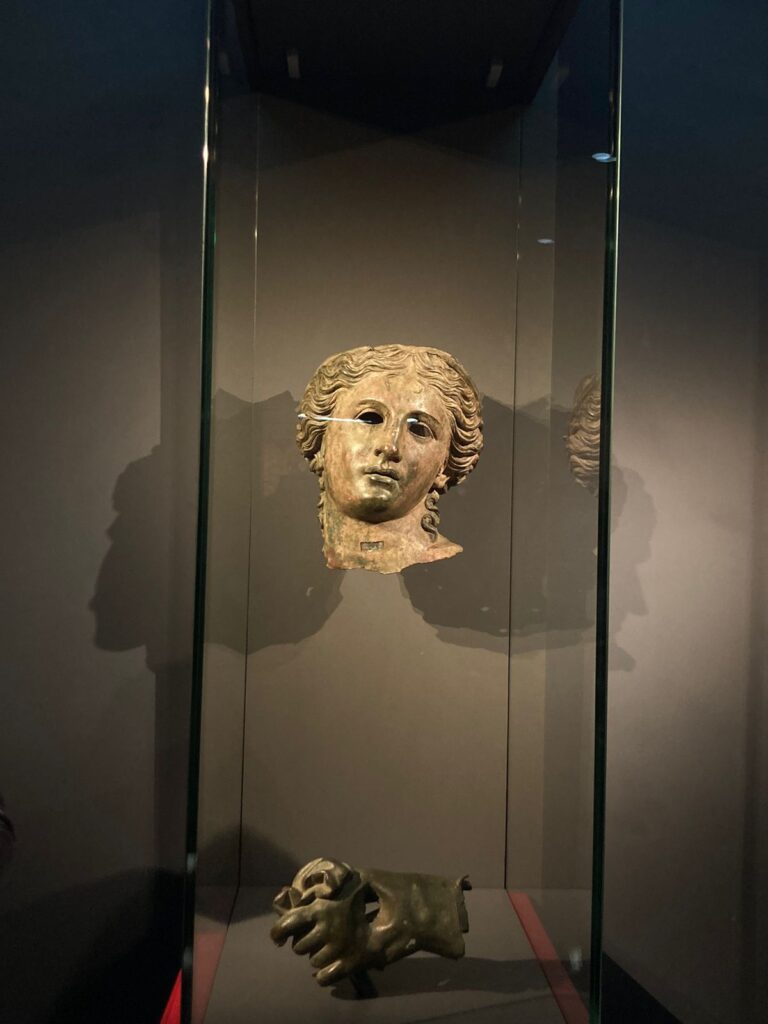In celebration of Armenia’s 33rd Independence Day, the British Museum loaned the statue of the Armenian goddess Anahit for a six-month exhibition in Yerevan.
Captivating visitors at the History Museum of Armenia since its grand opening on September 21, 2024, the exhibition “Mother Goddess: from Anahit to Mary” will run through March 21, 2025.
This exhibition, which features the bronze head and left hand of the Hellenistic statue of the goddess Anahit, came together through the efforts of the Keron Foundation in partnership with the Ministry of Education, Science, Culture, and Sports of Armenia, and the History Museum of Armenia, to celebrate the enduring legacy of the divine feminine in Armenian culture.
 Bronze head and left hand of the goddess Anahit statue
Bronze head and left hand of the goddess Anahit statueDuring the opening ceremony, Armine Zorabyan, a longtime staff member of the museum and a historical studies scholar, stated, “Bringing these statues from the British Museum to our museum is a clear acknowledgment of their deep connection to our culture. The British Museum rarely agrees to lend its artifacts, making this a truly exceptional case. Although the bronze head was unearthed in Sadak and later transported to Constantinople, its discovery took place in historical Armenia — a fact that should be universally recognized.”
The statue of Anahit, dating back to the second or first century BC, is believed to have been discovered in 1871 by a farmer in Satala (modern-day Sadak, Turkey). Often linked to the Greek goddess Aphrodite, the statue was later confirmed to be the head of Anahit, the Armenian goddess of fertility, healing, wisdom and water, who was venerated in the Armenian Highlands as a symbol of motherhood and abundance. After its discovery, the statue’s fragments journeyed through the hands of various antiquities dealers, and eventually, Italian art dealer Alessandro Castellani sold it to the British Museum in 1873 and later donated the left hand in 1875.
Known as the “Satala Aphrodite,” these pieces are being exhibited in Armenia for the first time, offering a rare opportunity to witness an integral piece of pre-Christian Armenian history. A replica of the statue is also preserved at the History Museum of Armenia.
The exhibition demonstrates the role the mother goddess had in the Armenian Highlands, which traces back to the Stone Age. Originally embodying the essence of a life-giving, nurturing woman, the mother goddess symbolized continuity and creation. Over time, she also came to represent agriculture, family well-being and healing.
The reverence for goddess Anahit dates back to ancient times, deeply rooted in the celebration of motherhood. From as early as the fourth century BC, her worship spread across Armenia and beyond, reaching Asia Minor, Syria and Iran. The Hellenistic and Roman periods further facilitated cultural exchange, blending Anahit’s identity with other deities and reinforcing her role as a powerful symbol of motherhood and creativity.
In addition to the bronze bust of Anahit, the exhibition features several other artifacts, positioning the statue as the centerpiece of a broader cultural showcase. This expansive exhibition is not only a celebration of the country’s sacred essence of motherhood but also its strength to persevere and showcase its resilience through its rich culture and history. Although this exhibition is not permanent, hosting it marks the first initial step toward greater achievements for Armenia’s art and cultural landscape.

